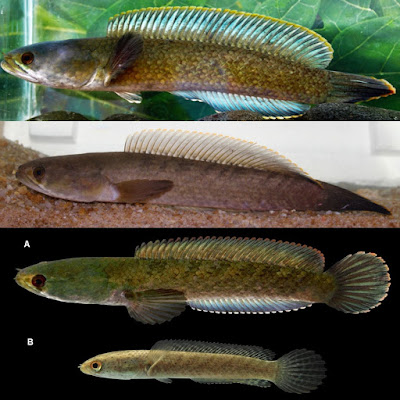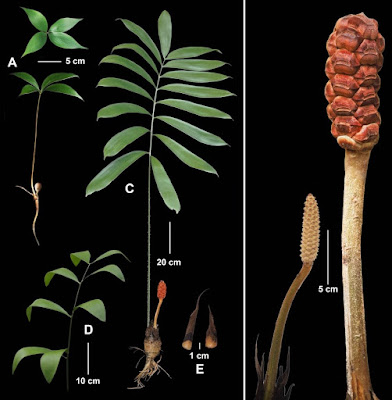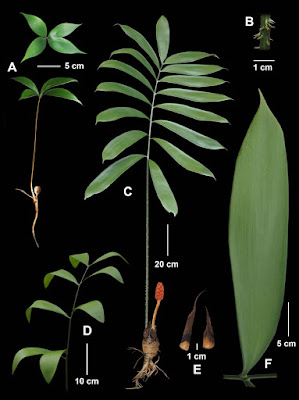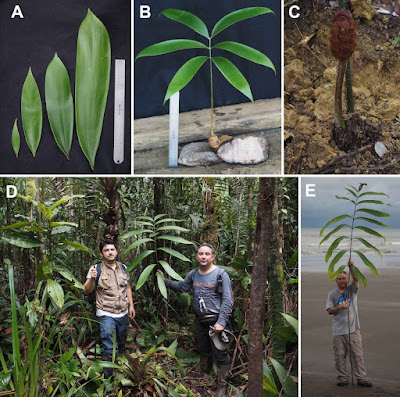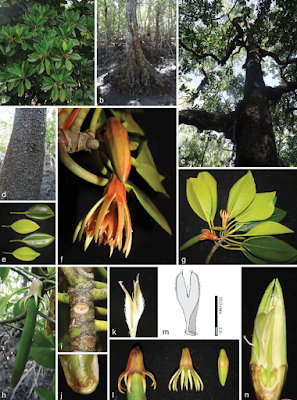[Most Recent Entries] [Calendar View]
Wednesday, January 2nd, 2019
| Time | Event | ||||
| 6:56a | [Ichthyology • 2018] Channa royi • A New Species of Snakehead (Teleostei: Channidae) from Andaman Islands, India
ABSTRACT A new species of snakehead fish Channa royi sp. nov., has been described based on 21 specimens collected from the South, Middle and North Andaman Islands, India. It is distinguished from all its congeners by a greenish-grey dorsum, pale brown to black pectoral fin with 2-3 inconspicuous semicircular bands, a series of 7-9 obliquely-arranged, saddle-like, dark olive to grey oblique streaks on green background on upper half of the body, 42-45 pored lateral-line scales, 12-13 branched caudal rays, 6-7 pre-dorsal scales, 43 vertebrae, two rows of teeth on the lower jaw, an outer row of numerous minute slender, pointed teeth and single inner row of large uniform sized teeth without any large canine like teeth on the anterior fourth of the lower jaw. Phylogenetically C. royi sp. nov. is closely related to C. harcourtbutleri, with a genetic distance (K2-P) of 2.4-2.8%, but morphologically differs in having greater inter-orbital width, fewer pelvic-fin rays (5 vs. 5-7, mode 6); fewer caudal-fin rays (ii- i, 10-12, i-ii vs. ii, 15, ii); more pre-dorsal scales (6-7 vs. 4) and fewer mid row lateral-line scales (9-13 vs. 15-16). Though Channa royi sp. nov. is a part of C. gachua species-group, it differs from the topotypic C. gachua from Bengal with higher pair-wise sequence distance of 19.5-20.9%. Keywords: Andaman Islands, Channa gachua, Channa limbata, Channa royi sp. nov., Channidae, Snakeheads
Channa royi, sp. nov. Praveenraj & Knight Common name: Andaman Emerald Snakehead Diagnosis: Channa royi sp. nov. is distinguished from all other species of the genus Channa belonging to the Channa gachua species-group by a combination of following characters: unique greenish-grey dorsum; upper half of body with a series of 7-9 obliquely-arranged, saddle-like, dark olive to grey oblique streaks on green background; throat with marbled pattern; 34-38 dorsal-fin rays; 22-25 anal-fin rays; 42-45 pored scales on body; 1-3 scales on caudal fin base; 3½ scales above lateral line and 6½ scales below lateral line; 6-7 pre-dorsal scales; 43 vertebrae; two rows of teeth on the lower jaw, single outer row of numerous minute slender pointed teeth and single inner row of enlarged uniform teeth without any large canine like teeth on anterior-fourth of the lower jaw; two rows of teeth on palatine; outer row with numerous minute sharp slender teeth and inner row with 4 to 6 large canine like teeth and pectoral fins pale brown to black in adults with 2-3 pale grey to black inconspicuous semicircular bands. .... Etymology: The species is named after Dr. S. Dam Roy, in appreciation for his immense encouragement and support for the exploration of the freshwater fishes of Andaman and Nicobar Islands. The species name is formed as a noun in the masculine genitive singular. The common name ‘Andaman emerald snakehead’ is given considering its unique greenish dorsum. Distribution: Channa royi sp. nov. is currently known only from South, Middle and North Andaman Islands, India and is abundant in ditches, ponds and hill streams of the sampled locations. The holotype was collected from clear, slow flowing water with cobble substrate without much aquatic vegetation. J. Praveenraj, J. D. M. Knight, R. Kiruba-Sankar, Beni Halalludin, J. J. A. Raymond and V. R. Thakur. 2018. Channa royi (Teleostei: Channidae): A New Species of Snakehead from Andaman Islands, India. Indian J. Fish. 65(4); 1-14. DOI: 10.21077/ijf.2018.65.4.72827-01 | ||||
| 10:39a | [Fungi • 2019] Enterographa assamica (Roccellaceae sensu lato) • A New Species from North-East India
ABSTRACT A new species Enterographa assamica, in the family Roccellaceae sensu lato is described from Assam, India. It is characterized by whitish grey thallus, rounded to elongate ascomata with yellowish-white thalline margin and presence of lichexanthone and confluentic acid in the thallus. A key to all the known species of Enterographa in India is also provided. KEY WORDS: Arthoniales; Assam; India; Enterographa assamica; Lichenized Ascomycota; Roccellaceae s. l.; Taxonomy.
Enterographa assamica Pooja Gupta, S. Joseph & G.P. Sinha sp. nov. Diagnosis: Thallus corticolous, epiperidermal; ascomata rounded to elongate; 0.25–0.55 mm diam., if rounded; 0.5–1(–1.2) × 0.2–0.5 mm, if lirelliform; asci clavate, 8˗spored, 60–80 × 15–19 μm; ascospores hyaline, acicular, transversely 7–11˗septate, slightly curved at the end, (39–)48–55(–60) × 2–3 μm; confluentic acid and lichexanthone present. Etymology: The specific epithet refers to the Indian state, Assam, where it was discovered. Pooja Gupta, Siljo Joseph and Gopal Prasad Sinha. 2019. Enterographa assamica, A New Species from North-East India. Taiwania. 64(1); 1-3. DOI: 10.6165/tai.2019.64.1 | ||||
| 11:09a | [Botany • 2018] Zamia paucifoliolata (Zamiaceae, Cycadales) • A New Species of Zamia from Valle del Cauca, Colombia
Abstract Zamia paucifoliolata, a new cycad species from the Pacific lowlands of Valle del Cauca, Colombia, is described and illustrated. It is distinguished from other species of Zamia by having an underground stem typically bearing large solitary leaves with eighteen or fewer leaflets, villous strobilar axes, microsporangia borne on both the abaxial and adaxial side of microsporophylls, and seeds that are longer than 18 mm. It is compared to Z. pyrophylla, Z. cunaria, and Z. ipetiensis, species which it most closely resembles. Keywords: Chocó biogeographic region, systematics, taxonomy, Gymnosperms Zamia paucifoliolata Calonje sp. nov. Diagnosis:— Zamia paucifoliolata most closely resembles Z. pyrophylla from which it is distinguished by the light green leaf flushes, the leaflets that are broader and less numerous, the fewer and larger mature megasporophylls and seeds, and the lighter colored pollen strobili. Etymology:— The specific epithet refers to the small numbers of maximum leaflets produced by leaves of this species which are among the least numerous of any species of Zamia. Leaves on adult plants carry between 10 and 18 leaflets (n=135 leaves, mode=10, mean 11.6), and only a few species with broad, prominently-veined leaflets carry the same number or fewer leaflets. Namely, Z. wallisii Braun (1875: 376), with the broadest leaflets in the genus, has leaves with a maximum of 11 leaflets, Z. dressleri Stevenson (1993: 6) carries up to 14 leaflets, and Z. imperialis Taylor et al. (2008: 421) similarly carries a maximum of 18 leaflets. The small number of leaflets carried by leaves of Z. paucifoliolata readily distinguishes it from its putative relatives Z. cunaria, Z. ipetiensis, and Z. pyrophylla, all of which carry a maximum of 32 leaflets. Ecology:— The known populations of the species appear to be viable, with a larger proportion of juveniles compared to adults, i.e. evidence of reproduction and regeneration. Plants are distributed in highly dense patches on the understory of the forest, on moderately steep slopes and near small streams. Little is known about leaf phenology, frequency or rate of strobilus production or germination time. Mature seed strobili with ripe seeds have been observed in February and May, whereas pollen strobili have only been observed in late August. Immature seed strobili have been observed in June, August, and September. There is no information yet about microrganisms associated to roots or species interactions involved in pollination or seed dispersal, but a good proportion of viable seeds has been observed in female strobili. The typical herbivores associated to Zamia species, Eumaeus Hübner (1819: 67), have not been observed yet either, but there were signs of herbivory by leaf miners. A permanent plot has been established in one of the populations to monitor population dynamics and other ecological aspects of the species. Michael Calonje, Cristina López-Gallego and Jonatan Castro. 2018. Zamia paucifoliolata, A New Species of Zamia (Zamiaceae, Cycadales) from Valle del Cauca, Colombia. Phytotaxa. 385(2); 85–93. DOI: 10.11646/phytotaxa.385.2.4 Resumen: Se describe y se ilustra Zamia paucifoliolata, una nueva especie de cícada de las tierras bajas del Pacífico Colombiano del Valle del Cauca. Se distingue de otras especies de Zamia por su tallo subterráneo típicamente cargando hojas solitarias con 18 folíolos o menos, ejes estrobilares vellosos, presencia de microesporangios en el lado abaxial y adaxial de los microesporofilos, y semillas de mas de 18 mm de longitud. Se compara con Z. pyrophylla, Z. cunaria, y Z. ipetiensis, las especies a las que más se asemeja. Palabras clave: Chocó biogeográfico, sistemática, taxonomía | ||||
| 2:40p | [Botany • 2018] Bruguiera × dungarra (Rhizophoraceae) • A New Hybrid between Mangrove Species B. exaristata and B. gymnorhiza recently discovered in north-east Australia
Abstract Bruguiera × dungarra (Rhizophoraceae), a previously undescribed hybrid species between B. exaristata and B. gymnorhiza is recorded from north-east Australia. Eight taxa are currently recognised in this Indo West Pacific genus, including three putative hybrids. The newly described hybrid is widely occurring, and it is described here with notes provided on typification, phenology, distribution and habitat. A revised identification key to all Bruguiera taxa is presented, along with a table of comparative diagnostic characters. Keywords: Bruguiera × dungarra; Rhizophoraceae; hybrid; identification key; intermediate; mangrove; taxonomy Bruguiera × dungarra N.C.Duke & Hidetoshi Kudo, hybrid nov. Etymology. The location of the type of this new hybrid occurs on the ancestral lands of the Yirrganydji people. For these traditional custodians of the narrow coastal strip from Cairns to Port Douglas, the epithet Dungarra means, ‘belonging to Machans Beach area’. Distribution — Type location is Machans Beach, near Cairns in Queensland,Australia. Other localities include Holloways Beach also near Cairns in Queensland, Australia, south to around Hinchinbrook Channel and Shoalwater Bay, and further north to the Marrett River estuary in Princess Charlotte Bay. Distribution elsewhere is likely, although possibly restricted to the zone of overlap of putative parents (Fig. 3). Putative parent species co-occur in eastern Indonesia, Timor Leste, southern New Guinea and northern Australia. In Australia, B. × dungarra is likely to occur from Darwin Harbour in the Northern Territory to Port Curtis in Queensland. Ecology & Local influences — Uncommon hybrid in the midhigh intertidal zone of intermediate estuarine position (sensu Duke 2006). Often in proximity of stands of higher intertidal B. exaristata, and mid-high intertidal B. gymnorhiza. Norm C. Duke and Hidetoshi Kudo. 2018. Bruguiera × dungarra, A New Hybrid between Mangrove Species B. exaristata and B. gymnorhiza (Rhizophoraceae) recently discovered in north-east Australia. Blumea - Biodiversity, Evolution and Biogeography of Plants. DOI: 10.3767/blumea.2018.63.03.03 A Cairns-based citizen scientist has made yet another remarkable discovery. |
| << Previous Day |
2019/01/02 [Calendar] |
Next Day >> |
